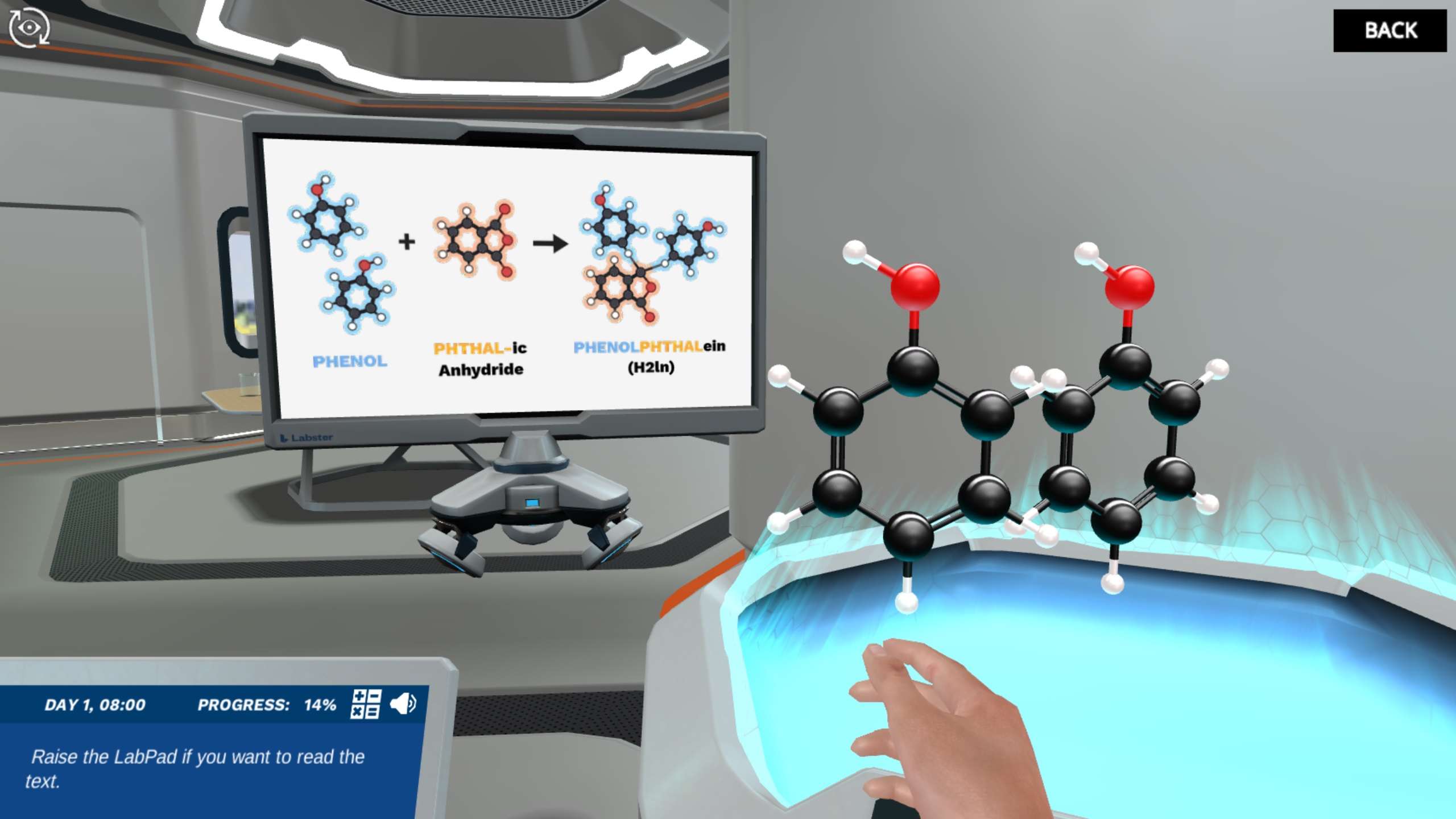Heading 1
Heading 2
Heading 3
Heading 4
Heading 5
Heading 6
Lorem ipsum dolor sit amet, consectetur adipiscing elit, sed do eiusmod tempor incididunt ut labore et dolore magna aliqua. Ut enim ad minim veniam, quis nostrud exercitation ullamco laboris nisi ut aliquip ex ea commodo consequat. Duis aute irure dolor in reprehenderit in voluptate velit esse cillum dolore eu fugiat nulla pariatur.
Block quote
Ordered list
- Item 1
- Item 2
- Item 3
Unordered list
- Item A
- Item B
- Item C
Bold text
Emphasis
Superscript
Subscript
About This Simulation
Discover the rainbow inside phenolphthalein and how to unlock its colors through changing the pH. Take a deep dive to the molecular level to learn why chemicals are the color they are and put this all to use in the phthalein-dye test for phenols.
Learning Objectives
- Identify the reagents for the test
- Justify the environments for the reactions (acidic/ heated)
- Recall the steps to safely perform the Phthalein-Dye test
- Distinguish between positive and negative results
- Discover the relationship between colour and pH for phenolphthalein
About This Simulation
Lab Techniques
- The Science of Colors
- Functional Group chemical testing
Related Standards
- NA
- HS-PS1-3
Learn More About This Simulation
Fluorescent colored solutions, acid, and fire; what more could you ask for in chemistry!? In this simulation you will learn about phenolphthalein, a multi-colored molecule that acts as a color indicator to detect phenols in the phthalein-dye test. Get hands on, building this focal molecule yourself before discovering how its shape and color change over the pH scale. After learning the science on seeing colors it time to put it all to use performing the test for phenols yourself under the ever-helpful supervision of Dr. One.
Everything to know about Phenolphthalein First you will learn how to build phenolphthalein from its ingredients, building the molecule together on the holotable. Next we’ll see how phenolphthalein gets its useful color changing property by discovering all the colors it forms. Finally put your new knowledge to use and learn the steps to detect the phenol functional group. Master the Test for Phenols In this simulation you will see phenolphthalein in 15 different pH levels in 15 different beakers; that's a lot of setting up to do. But in the virtual lab we have experiments that clear away when you close the tab. In a real lab, students may focus on the ‘Dye’ part of the phthalein dye test, going home with pink stained fingers. In this sim we focus on the ‘Phthalein’ part of the test, allowing science and learning to be at the forefront. Finish with Flying Colors! The reactants are waiting. All it takes is a few simple steps, a spatula here, a drop of acid there..knowing why it all works is the hard part. When you’ve finished the heavy lifting by learning the science, this is where the fun begins. All that's left is to prove you can use your new skills and observe a vibrant color change. Think you can handle that?
For Science Programs Providing a Learning Advantage
Boost STEM Pass Rates
Boost Learning with Fun
75% of students show high engagement and improved grades with Labster
Discover Simulations That Match Your Syllabus
Easily bolster your learning objectives with relevant, interactive content
Place Students in the Shoes of Real Scientists
Practice a lab procedure or visualize theory through narrative-driven scenarios


FAQs
Find answers to frequently asked questions.
Heading 1
Heading 2
Heading 3
Heading 4
Heading 5
Heading 6
Lorem ipsum dolor sit amet, consectetur adipiscing elit, sed do eiusmod tempor incididunt ut labore et dolore magna aliqua. Ut enim ad minim veniam, quis nostrud exercitation ullamco laboris nisi ut aliquip ex ea commodo consequat. Duis aute irure dolor in reprehenderit in voluptate velit esse cillum dolore eu fugiat nulla pariatur.
Block quote
Ordered list
- Item 1
- Item 2
- Item 3
Unordered list
- Item A
- Item B
- Item C
Bold text
Emphasis
Superscript
Subscript
A Labster virtual lab is an interactive, multimedia assignment that students access right from their computers. Many Labster virtual labs prepare students for success in college by introducing foundational knowledge using multimedia visualizations that make it easier to understand complex concepts. Other Labster virtual labs prepare learners for careers in STEM labs by giving them realistic practice on lab techniques and procedures.
Labster’s virtual lab simulations are created by scientists and designed to maximize engagement and interactivity. Unlike watching a video or reading a textbook, Labster virtual labs are interactive. To make progress, students must think critically and solve a real-world problem. We believe that learning by doing makes STEM stick.
Yes, Labster is compatible with all major LMS (Learning Management Systems) including Blackboard, Canvas, D2L, Moodle, and many others. Students can access Labster like any other assignment. If your institution does not choose an LMS integration, students will log into Labster’s Course Manager once they have an account created. Your institution will decide which is the best access method.
Labster is available for purchase by instructors, faculty, and administrators at education institutions. Purchasing our starter package, Labster Explorer, can be done using a credit card if you are located in the USA, Canada, or Mexico. If you are outside of North America or are choosing a higher plan, please speak with a Labster sales representative. Compare plans.
Labster supports a wide range of STEM courses at the high school, college, and university level across fields in biology, chemistry, physics, and health sciences. You can identify topics for your courses by searching our Content Catalog.















